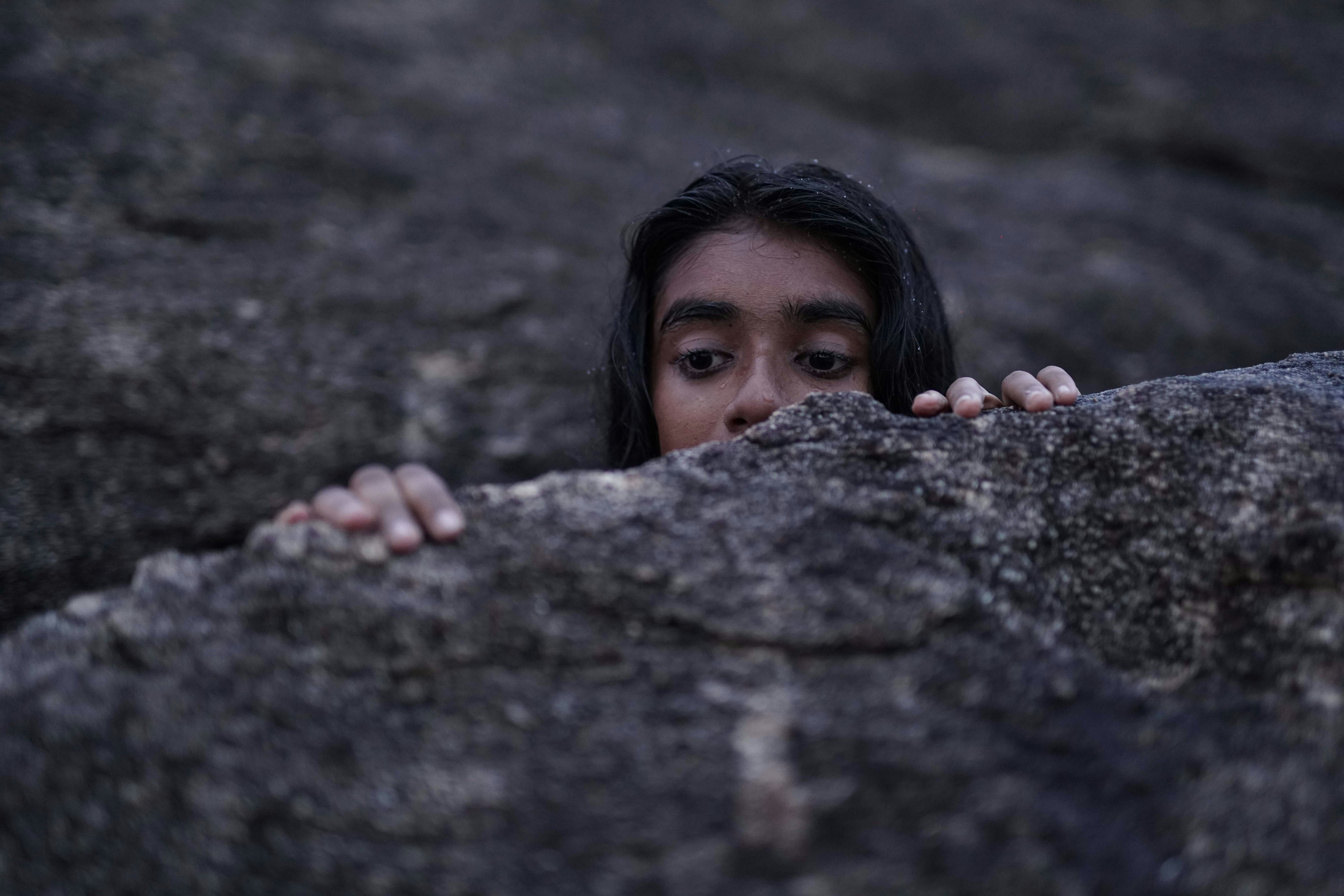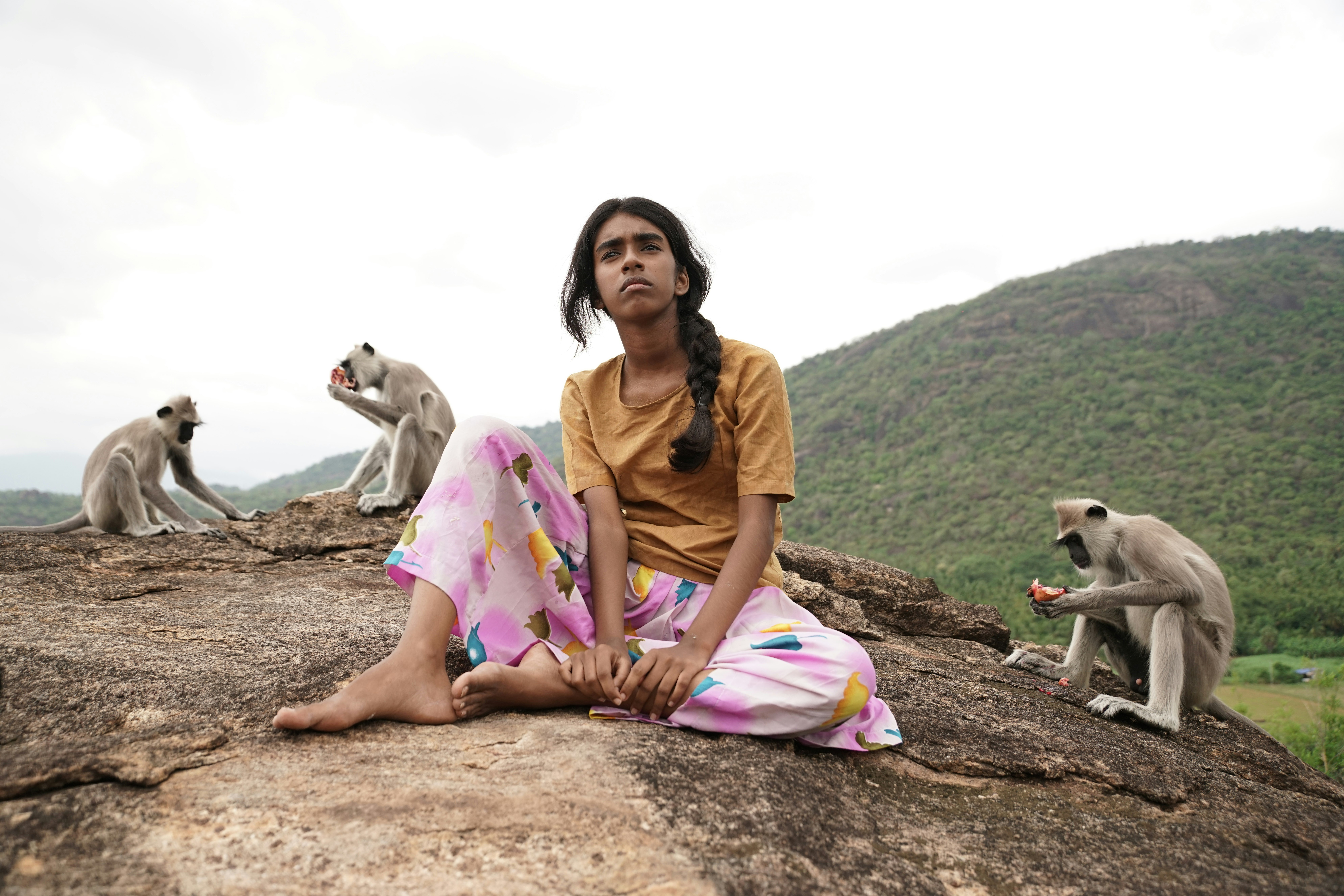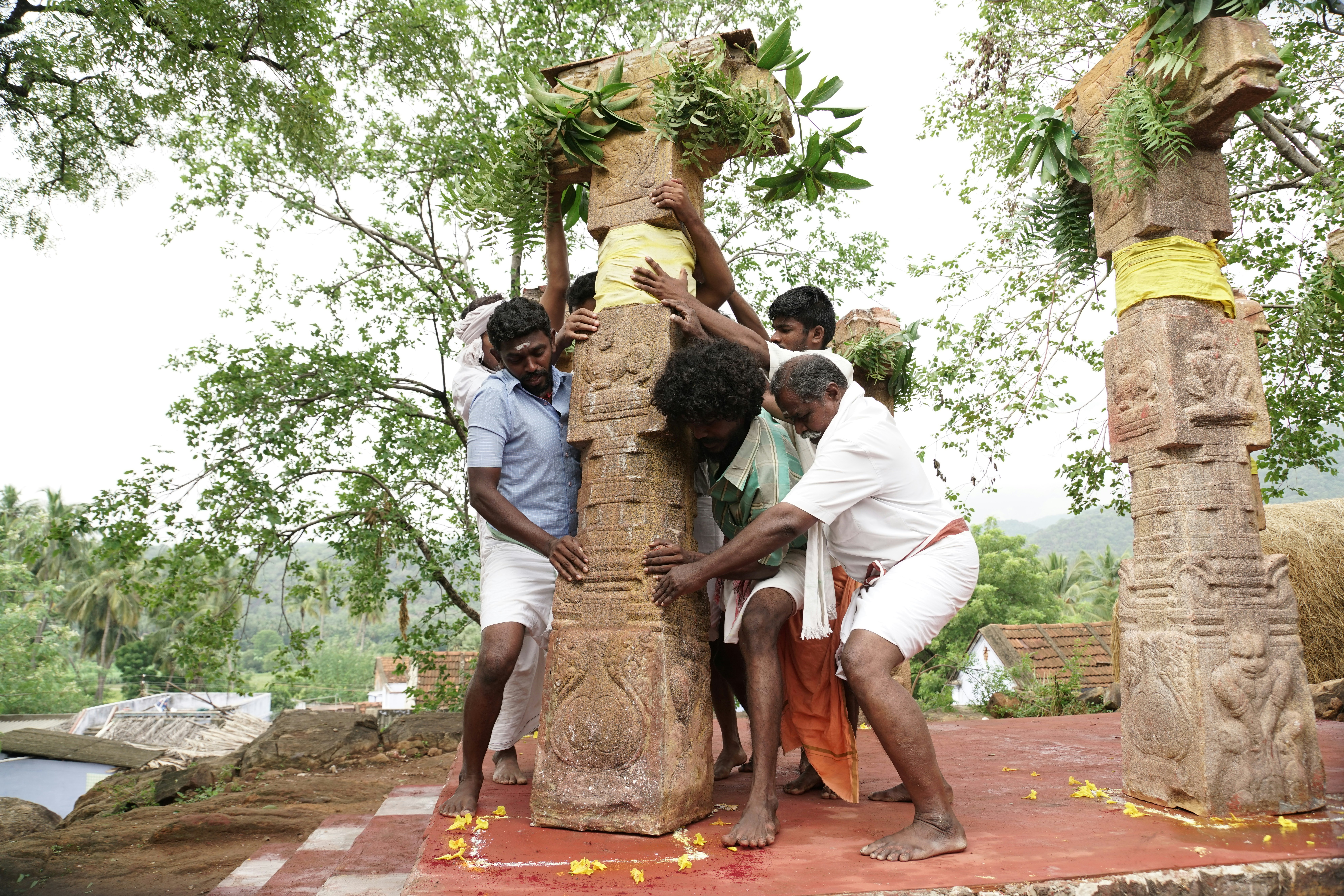Ritual Offering: The Politics of Womanhood in Leena Manimekalai’s Maadathy
Deepa Bhasthi

In some Indian communities, there is a practice of celebrating a girl’s entry into womanhood. Once she starts menstruating, she is attired in bridal-like finery, perhaps given gifts of gold. Her coming-of-age is announced formally to society. The ritual announces that she is biologically ready to be married, had sex with, made mother of. Or alternatively, ready to be controlled, tamed, domesticated, her desires appropriated, and employed in the machinery of patriarchal geographies.
The late Kannada writer Dr U. R. Ananthamurthy had a favourite metaphor, that of the ‘backyard’ and the ‘frontyard’ that he often used in lectures and writings to understand and explain the dynamics of culture. According to Ananthamurthy, the frontyard was a male space, where political, spiritual and other worldly matters were discussed. The backyard belonged to the women and was where they met, shared secrets, discussed intimate, physical experiences like menstruation and childbirth. It was where emotions were openly on display. He said that the writer in him came from the backyard, which was where ‘life’ happened, and the frontyard could only produce professors. A girl’s entry into eventual womanhood is thus a full membership to the backyard, a joyous occasion, albeit one that brings much responsibility. It also brings a seriousness to her conduct that stems from being a step away from the carefreeness of childhood. But the privilege of celebrating a girl growing up is also restricted to certain well-placed castes.

For a girl from an oppressed class and caste, puberty is a licence for men from the oppressor class-castes to abuse, rape, own, use and discard according to their fancies. Danger lies in every breath the oppressed takes. In India’s rigidly practised caste system, the caste community one is born into determines a person’s entire life – what she studies, eats, wears, where she can work (or not), who she can marry, where she can live (if at all) and so on. One could perhaps draw parallels between the caste system and racial discrimination in other parts of the world, where in both cases the systemic violence and oppression particularly affects women, transpeople and other minorities. To put it more bluntly, an upper caste man in India enjoys privileges similar to those available to a white heterosexual man in the Western world.
Beauty, sexual awakening, desire, marriage, leisure, food, laughter, and such other ingredients of life manifest the fullest in the youth of a girl on the brink of womanhood. These are typically, happy, pleasant, joyous. But Maadathy: An Unfairy Tale, a Tamil-language film by Indian filmmaker Leena Manimekalai fleshes out just how deeply these simple life-things are affected by, and tied to the complex horror and multi-pronged violence of the Hindu varna/caste system.

The film, which premiered at the Busan International Film Festival in October 2019 and was released in India in June 2021, focuses on a brief period in the life of a family of Puthirai Vannars – a sub caste of the severely oppressed Dalits. They are called the ‘unseeables’ because they are not only untouchable, but cannot be seen by the upper castes, which, in a particularly cruel twist of social violence, includes the Dalits too. It gazes, in particular, at Yosana (Ajmina Kassim), a young woman just out of her adolescence. She is defined by an innocence and hope that any viewer aware of how violently caste matters are performed in India knows is going to be brutally robbed from her.
Even then, the violence in the way the upper caste men in the village treat her family is staggering in its sheer brutality. One briefly wonders, ‘could this community be somewhat fictional?’ until a quick web search reveals that indeed, the Vannars, numbering in their thousands, and pushed to the fringes even within the Dalit discourse, still live this way in some villages in Tamil Nadu. What is shown on screen is probably not even the worst of the crimes committed against them.

The Puthirai Vannars are expected to move around only at night and rush back to their huts at the very edge of villages at first light, the burden of not being seen entirely falling on them. They are forced to wash the clothes of the villagers, including menstrual cloths of the women. They are also expected to clean dead bodies and dig graves in exchange for some measure of grain and bottles of country liquor every year, and some coins flung at them now and then.
There is a suggestion in Maadathy that families such as Yosana’s might be brought into villages and treated almost like slaves, in not being allowed to cross the river – crossing, another frequent subtext – to visit relatives. Alongside the everyday humiliation, a Vannar woman is considered a free-for-all sex slave. She might be unseeable otherwise, but both touch and sight are acceptable to the upper caste men when they rape and assault her.
Naturally, Veni (Semmalar Annam), the mother in Maadathy is petrified for her daughter – “What a curse to be born a beautiful girl in this slave caste,” she says – because Yosana, whose name, it took me a while to realise, means ‘thought’ in Tamil, is a free spirit.

"She likes to spend her days in the forest, swimming, dreaming, being around animals and engaging in other idyllic activities. In other words, she is, as is her ecofeminism, untamed, uncontrollable, and therefore a problem for patriarchy."
For there is perhaps no greater perceived threat to patriarchal oppression than a woman who speaks her mind, forms her own opinions, and does not care what people say or think about her. Veni, the mother, is entrenched in patriarchy, ‘tamed’, even if grudgingly, into the system of violence that men unleash on her. Whereas the freer Yosana, a virgin in body and thought, threatens the fabric of the status quo.
In one of the most mesmerising scenes in the film, the camera follows Yosana’s gaze as it moves over the body of Panneer (Patrick Raj), a donkey herder who is swimming in the river. In Indian cinema, it is a rare portrayal of sexual desire via the female gaze. It is naked in its intensity, even if Yosana is probably not old enough to fully comprehend her feelings.
Manimekalai’s films, including Goddesses (2007) and Sengadal: The Dead Sea (2011), have always probed themes of feminism and class-caste conflicts. While such subjects have been addressed extensively in both mainstream and parallel Indian cinema to various degrees, Manimekalai’s works, particularly noteworthy for their unabashed critique of patriarchy, have rarely gone down well with the upper caste communities that directly benefit from such systemic oppression. Most recently, she received severe backlash, and many death threats, for “hurting religious sentiments” from Hindutva nationalists for sharing a poster of her 2022 performance documentary Kaali where the goddess is smoking a cigarette.
The chaste, sanitised Brahminical representation of gods and goddesses that the Hindutva nationalists prefer to promote seeks to erase the fact that ritualistic offering of meat and liquor is widely practised across the country by various communities. Neither do religious figures all behave in a supernatural manner, like the right-wing would want them to. Many are given to enjoying the ingredients of life like food and sex just as naturally as the human beings who seek their protection.

In straddling the intersection of gender and caste in Maadathy, Manimekalai blends the supernatural and the mythological to weigh in on the hypocritical way the patriarchy venerates goddesses in temples and desecrates the bodies of women considered lesser.
Maadathy begins as a story of a newly-married couple on their way to the Maadathy temple. The title sequence reads: The Indian subcontinent is a land of a million subaltern deities; Behind many of these deities there is a tale of injustice. The woman gets her periods, and asks her husband to fetch a piece of cloth from a hut they spot in the distance, given that they are miles away from finding an alternative for her to use. The man leaves, and failing his return, the wife follows to find a young boy inside the hut surrounded by realistic paintings – Manimekalai’s choice of narrative device – that offer to tell her and us a story as narrated by the boy. It will turn out to be story of a young girl who lived a brief life. She died, becoming a deity called Maadathy.
Human beings who became daiva (I use a Kannada term here, in Tamil there could likely be a slight difference in pronunciation), spirits or protectors of the subaltern are culturally significant, and notably, distinct from established Brahmanical gods and ritual practices in several parts of southern India. In the coastal Karnataka region that I am particularly familiar with, Tulu culture has innumerable such bhootas and daivas, deriving their origins from animals, nature, and humans. The latter, scholars like Dr Chinnappa Gowda, Amruta Someshwara and others who have researched the culture for decades say, were often heroes or prominent men and women in a community who usually met an untimely, unnatural end and have come to be revered. These communities, who are always oppressed, met caste violence that ended in death not with an acceptance of the finality of ‘death,’ terming it instead as a ‘disappearance’ which leaves room for a possible return. The daiva, at some later stage, evolves from a disappeared person into a deity who returns when ritualistically summoned. They demands favours – offerings, a shrine, years of rituals – from the community, almost as revenge for his-her forced disappearance.

To note, these daivas are revered by both the subaltern, and at least in the Tulu region, by the upper castes as well, circling back to the portrayal in Maadathy of the generationally practised hypocrisy of murdering the flesh and worshipping the stone. In the film, Yosana is gang raped by a group of young men, included her crush Panneer, who has never been aware of her desire for him, on the very night that a local temple has been built and the consecration ceremony to install the idol unfolds in the background. When she dies, it unleashes terrible times for the village. Her parents are allowed to cross the river. Veni, her husband Sudalai (Arul Kumar) and his parents are seen with Yosana’s corpse in the day time, before the new temple. They defy the restrictions they had to adhere to, making it convenient for the irate villagers to send them away.

When Yosana becomes Maadathy, it offers the viewer an origin story and further suggests how the origin of many subaltern deities is steeped in injustice and violence much like the Tulu spirits in Karnataka. The villagers remain blind to the double standards, to the brutality and to the internalised violence of caste differences. In the last painting in the storyteller’s hut, the new husband features as a blind villager – perhaps a proxy for us viewers and our hypocrisies. It is indicative of just how deeply entrenched and casually normalised caste violence is, even for a husband otherwise open-minded enough to go looking for a menstrual cloth.

Maadathy is an uncomfortable watch. Even as Yosana walks around the forest, swims, runs with the wind, one knows it is a disquieting peace on screen. This terrible tension builds up throughout the movie, and one cannot help but reflect on personal stories of growing up in patriarchal India. I was born in an upper caste, so I could not dare to say I understand what girls like Yosana, and older women like Veni go through. Our experiences of oppression at the hands of the male-oriented society are simple incomparable. The themes of patriarchy’s desire to control and repress the female gaze, my sexuality, the agency to express, even think, feel very familiar. The objective remains universal, even as the methods used vary across the female spectrum. The sheer casualness of caste violence that Manimekalai shows in the film reminds us of just how much work there remains to be done before we can imagine an equal and just society.
Notes
All image captions:
Maadathy, film production still, 2019; courtesy Leena Manimekalai
About the contributor
Deepa Bhasthi is a writer, translator and farmer-in-progress based in Kodagu, southern India.
